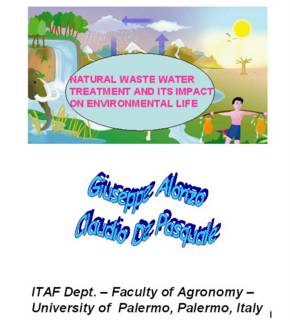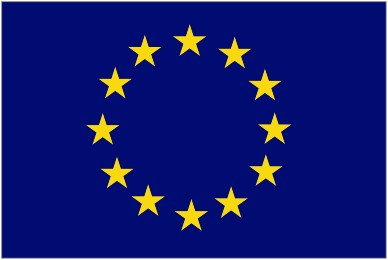NATURAL WASTE WATER TREATMENT
AND ITS IMPACT ON ENVIRONMENTAL LIFE
Giuseppe Alonzo, Claudio De Pasquale
ITAF Dept. – Faculty of Agronomy – University of Palermo, Viale delle Scienze,
90128 Palermo, Italy
alonzo@unipa.it, claudiodep@hotmail.com
AND ITS IMPACT ON ENVIRONMENTAL LIFE
Giuseppe Alonzo, Claudio De Pasquale
ITAF Dept. – Faculty of Agronomy – University of Palermo, Viale delle Scienze,
90128 Palermo, Italy
alonzo@unipa.it, claudiodep@hotmail.com
The total volume of water on the Earth is vast, 1.4 billion km3 (1).However, the proportion of this that is fresh and reasonably accessible is less than 1%, at 11 million km3. There is, therefore, no shortage of water on this planet, just a lack of accessibility to fresh water at some places at some times. Agriculture is the largest user of freshwater, accounting for around three quarters of the entire global consumption (2). However, agriculture does not `consume' water in the conventional sense, since (globally) insignificant amounts of water are actually bound up in the commodities produced. The large amount of water used by agriculture are released through evaporation, which is eventually recycled as rainfall. Agricultural use of water is, therefore, usually much more environmentally clean than domestic or industrial uses, where degradation of the water quality makes its reuse difficult without expensive treatment. It should be noted that the preceding estimates of global water resources and their consumption by agriculture are at best educated guesses (3) and will remain so until more consistent schemes are adopted for the collection, quality control and interpretation of hydrological data.
Even with the uncertainties in global water use, agriculture remains by far the largest user of freshwater. It has been estimated that global demand for food, fuel and fibre provided by agricultural crops will increase by a factor of between two and six during the next two generations (4). Currently, one sixth of the human population goes hungry on a regular basis and 1 billion people do not have access to clean water (5). Two hundred and thirty million people are living in some 26 countries considered to be water scarce. Countries are normally considered to be water scarce when annual internal renewable water resources are less than 1000 m3 per capita per year. By 2020, the number of water scarce countries is likely to approach 35. Where scarcities loom, competition between industrial, domestic and agricultural water users intensifies and, typically when supplies tighten, agricultural users lose out.
Moreover, the longer term threat of climate change, as a result of the build up of greenhouse gases, casts ominous shadows over future water budgets (6).
The global statistics on water resources and forecasts of future needs have prompted many predictions of a crisis in the availability of water resources. It is argued in this paper, however, that this crisis can be averted by managing water resources more efficiently and that this is best achieved within a framework of integrated catchment management (ICM). It is also argued that adopting programmes of ICM can be a key step towards sustainable agricultural development, particularly in semi-arid areas.
Unfortunately, there is little consensus on the definitions of ICM and sustainable agricultural development (SAD). ICM can be defined as the co-ordinated planning and management of land, water and other environmental resources for their equitable, efficient and sustainable use at the catchment scale. There have been many attempts to define sustainability in absolute terms and, since the Brundtland Commission's definition of sustainability in 1987, at least 70 more definitions have been constructed, each different in subtle ways, each emphasising different values, priorities and goals (7). This said, a definition of SAD that has gained a reasonable level of acceptance is the one proposed by the FAO (1990), whereby SAD is defined as the management and conservation of the natural resource base and orientation of technological and institutional change in such a manner as to ensure the attainment and continued satisfaction of human needs for present and future generations. Such sustainable development conserves land, water, plant and animal genetic resources, is environmentally sound, technically appropriate, economically viable and socially acceptable.''
To many institutions and agencies, ICM is solely an improvement in catchment planning, whereby relevant central institutions work constructively and in collaboration.
However, for sustainable agricultural development in a given catchment to be achieved, other stakeholders must participate in the decision-making and implementation processes.
Major features of ICM programmes, that are beginning to show positive results, include: an overall natural resource management strategy that clearly defines the management objectives, a range of delivery mechanisms that enable these objectives to be achieved and a monitoring schedule that evaluates programme performance; decision-making and action take place at the basin-wide, regional and local levels.
Wherever possible, local communities are involved both in decision making and in resulting activities; mechanisms and policies are established that enable long-term support to programmes of environmental recovery.
To protect our groundwater and rivers from impurities, waste water has to be cleaned properly. Our modern sewage treatment plants are expensive, inefficient, and not very effective.
Natural waste water treatment features small decentralized sewage treatment facilities which use the natural purifying characteristics of marsh plants. These facilities are operating successfully in Germany, Switzerland, and the Netherlands and could be more efficient in Mediterranean area.
The use of wetlands for treatment can significantly lower the cost of wastewater treatment because the systems rely on plant and animal growth instead of the addition of power or chemicals. Also, the plant communities present in the wetlands naturally adjust to changing water levels and water quality conditions by shifting dominance to those species best adapted to growing under the new conditions.
Wetlands mean different things to different people. All wetlands are highly productive systems and support high biodiversity. Like other ecosystems, wetlands perform many ecological functions. The hydrological, biological and biogeochemical functions impart them various values. However, it is important to recognize that not all wetlands are similar in their function.
Nutrient transformation is one of the major wetland functions which is translated into their value for improving the quality of wastewater. Wetlands are now constructed worldwide, designed especially for secondary and tertiary treatment (8). They offers many advantages over the traditional oxidation pods.
Aquatic plant are an essential component of constructed wetlands, and contribute to the nutrient transformation by abetting in the physical, chemical, and microbial process besides removing nutrients for their own growth (9). They offer mechanical resistance to the flow, increase the retention time and facilitate settling of suspended particulates. They improve conductance of the water through the soil as the roots grow and create spaces after their death. The plant add organic matter into the water as well as providing a large surface area for microbial growth. Many aquatic plants actively transport oxygen to the anaerobic layers of the soil and thus help in oxidation and precipitation of heavy metals in the root.
One of the main considerations in promoting the use of constructed wetlands is their relatively low cost for construction, operation and maintenance, relative to the conventional treatment systems.
Estimates of the land requirement for treating per capita domestic waste based on the nutrient loading rates vary from 10 to 20 person per hectare. The land prices is one of the major deterrent. It is often argued that the wetland systems are more suitable for the tropical/subtropical regions, because of high temperature permitting growth throughout the year. The source and quality of the wastewater are also important factors which should be seriously considered when recommending constructed wetlands in developing country.
References
1. Maidment, D.R., 1992. Handbook of Hydrology, McGraw, New York.
2. Shiklamanov, I.A., 1991. The world's water resources. In: Proc. Int. Symp. to commemorate 25 years of IHP.
UNESCO/IHP, pp. 93±126.
3. Rodda, J.C., 1995. Guessing or assessing the world's water resources. J. IWEM 9, 360-368.
4. Penning de Vries, F.W.T., Rabbinge, R., 1997. Potential and attainable food production in different regions.
Phil. Trans. Roy. Soc. London, B.
5. Serageldin, I., 1995. A global vision and required action. Proc. of 2020 Vision for Food, Agriculture and the
Environment Conf, IFPRI, Washington DC, pp. 129-133.
6. Postel, S.L., 1993. Water and agriculture. In: Gleick, P.H. (Ed.), Water in Crisis: A Guide To The World's Fresh
Water Resources, Oxford University Press, Oxford, pp. 56-66.
7. Pretty, J.N., 1995. Regenerating agriculture: policies and practice for sustainability and self-reliance, Earthscan,
London.
8. Kadlec, R . and Brix, H. ,1995. Wetland Systems for water pollution control. Wat. Sci. Tech., 32
9. Brix, H. 1997.Do macrophytes play role in constructed treatment wetlands. Wat. Sci. Tech., 35
This lecture was delivered by the writers during the project meeting in Carini-Sicily- Italy (October 2003)




















0 Comments:
Post a Comment
<< Home